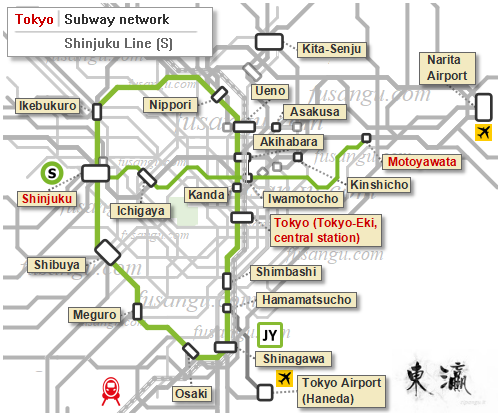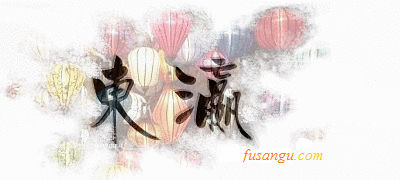
The Shinjuku-sen is one of the four subway lines managed by Toei, a municipal transportation company.
The line runs north of the city centre, connecting some of the city’s most popular tourist areas such as Shinjuku, Bunkyo, Ueno. The line continues into the eastern suburbs where it connects to the lines that serve the connection with Chiba and Narita Airport.
In this page we describe a one-day tour along the Shinjuku Line. The article includes a programme suitable for short stays.
Main sightseeing places along the Shinjuku Line
The Shinjuku Line runs along a west-east direction north of the centre of Tokyo. The line connects the following areas:
-
Shinjuku, the core of the modern city, a large district known as an entertainment hub. Shinjuku offers also a few sightseeing places of notable cultural importance;
-
Chiyoda, central district. A major station served by Shinjuku Line, the Kudanshita Station, is very close to Yasukuni Shrine;
-
Bunkyo, a central district where you can find important traditional gardens, temples and shrines;
-
Ueno, a neighbourhood of Taito district, most noted for the presence of important museums and a large park; here are some interesting temples and shrines;
-
Chuo, central district. The Shinjuku Line serves the area of Bakurocho, where you can find lots of hostels and cheap mid-range hotels;
-
Morishita: a neighbourhood famous for the numerous sumobeya, traditional sumo schools;
-
Ichikawa, where is the terminus, Motoyawata Station, a small town where are a few ancient temples and shrines such as Hokekyo-Ji and Katsushika Hachiman Shrine.
Recommended itinerary along the Shinjuku Line
We suggest you begin your tour starting from Iwamotocho Station, near Akihabara:
-
9:00 - 11:00: visit to Akihabara, the otaku The core of the district lies next to Akihabara Station. You can reach it on foot from Iwamotocho Station. The area is rich in shops that cater to anime, manga, video games and modellism buffs. Below the viaduct of the Yamanote Line (linking Ueno and Akihabara) are a few boutiques and craftsmen’s shops;
-
11:00 - 11:30: lunch near Akihabara;
-
11:45 - 12:45: visit to Jimbocho. The area is famous for the copious presence of elegant cafes and large bookshops;
-
13:00 - 14:30: visit toYasukuni Shrine. The famous shrine is a few steps away from Kudanshita Station. After visiting Yushukan Museum you can take a walk along the northern moat of the Imperial Palace. Not to be missed in spring is Chidorigafuchi;
-
15:00 - 19:00: visit to Shinjuku. Aside from the large commercial area next to Shinjuku Station, a real maze, you can begin your visit with a few museums. One of them is Shinjuku Historical Museum, close to Akebonobashi Station and the Toy Museum. We suggest you also include a visit to Shinjuku-Gyoen, a large park. You can then spend the evening and night in Shinjuku, centre of Tokyo’s night life.
Related articles:
Main article: Tokyo 3-day itinerary
Itineraries along the subway lines (Asakusa, Hibiya, Ginza, Marunouchi, Tozai, Mita, Namboku, Yurakucho, Chiyoda, Shinjuku, Hanzomon, Oedo, Fukutoshin)

